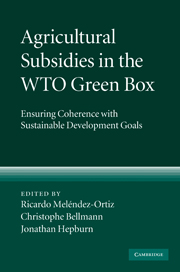Book contents
- Frontmatter
- Contents
- List of contributors
- Preface
- Acknowledgements
- List of abbreviations
- 1 Overview
- PART I The recent evolution of agricultural trade policy reform
- PART II The focus, extent and economic impact of green box subsidies
- PART III Green box subsidies and developing countries
- 11 Agricultural subsidies in the WTO green box: opportunities and challenges for developing countries
- 12 Use of green box measures by developing countries: an assessment
- 13 A Chinese perspective on the green box
- 14 African countries and the green box
- PART IV Green box subsidies and the environment
- PART V Looking forward: how can change take place?
- Appendix: Text of Annex 2 of the WTO Agreement on Agriculture (“the green box”)
- Index
12 - Use of green box measures by developing countries: an assessment
from PART III - Green box subsidies and developing countries
Published online by Cambridge University Press: 03 May 2010
- Frontmatter
- Contents
- List of contributors
- Preface
- Acknowledgements
- List of abbreviations
- 1 Overview
- PART I The recent evolution of agricultural trade policy reform
- PART II The focus, extent and economic impact of green box subsidies
- PART III Green box subsidies and developing countries
- 11 Agricultural subsidies in the WTO green box: opportunities and challenges for developing countries
- 12 Use of green box measures by developing countries: an assessment
- 13 A Chinese perspective on the green box
- 14 African countries and the green box
- PART IV Green box subsidies and the environment
- PART V Looking forward: how can change take place?
- Appendix: Text of Annex 2 of the WTO Agreement on Agriculture (“the green box”)
- Index
Summary
Disciplining farm subsidies has been one of the main objectives of the multilateral trading system ever since agriculture was included in the negotiating mandate for the Uruguay Round negotiations in 1986. The decision to extend multilateral trade rules to the agricultural sector reflected the desire of the GATT contracting parties to rein in the market-distorting subsidies. The negotiating mandate for the Uruguay Round was thus adopted to improve “the competitive environment by increasing discipline on the use of all direct and indirect subsidies” (emphasis added). However, while agreeing to the Agreement on Agriculture (AoA), the eventual outcome of the Uruguay Round negotiations on agriculture, the GATT contracting parties adopted a more nuanced approach to the disciplining of farm subsidies.
While introducing the discipline on farm subsidies, the AoA adopted a three-tiered structure in respect of the production-related subsidies, the so-called domestic support. The discipline was ostensibly based on the perceived distortions caused by each of the three sets of subsidies. Thus, subsidies that directly influenced prices and production, including price support measures and input subsidies, were reined in. These subsidies had to be reduced if they exceeded the threshold, identified as the de minimis level, and could not exceed the de minimis level if the actual spending was below this threshold. However, subsidies that “have no, or at most minimal, trade-distorting effects or effects on production” were not subjected to any discipline.
- Type
- Chapter
- Information
- Agricultural Subsidies in the WTO Green BoxEnsuring Coherence with Sustainable Development Goals, pp. 369 - 398Publisher: Cambridge University PressPrint publication year: 2009



